Hasegawa 1/72 P2V-5F conversion
|
KIT #: |
? |
|
PRICE: |
$10.00 waaaay back when
|
|
DECALS: |
Two options |
|
REVIEWER: |
Carmel J. Attard |
|
NOTES: |
Falcon conversion set utilized. |
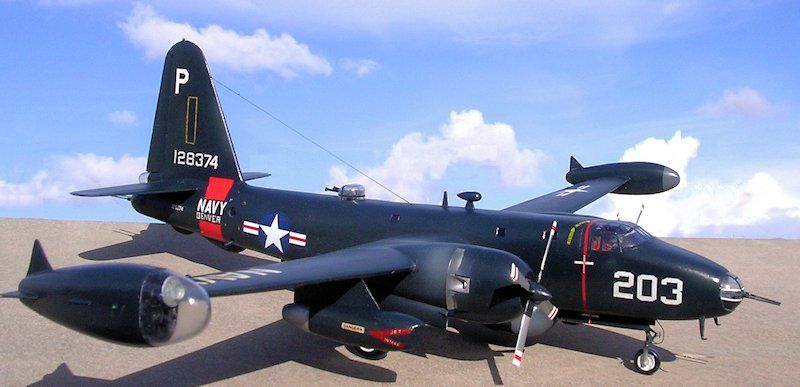
The
concept of the Neptune P2V5 a twin engine type, which was delivered to both the
RAF and US Navy besides other nations, goes back to the war years when initial
studies on a land based patrol aircraft for service with the US Navy were made
by Lockheed’s Vega subsidiary in 1941. Owing to urgency of aircraft production
before and during the early years of WWII no further development of this design
followed until 1944.
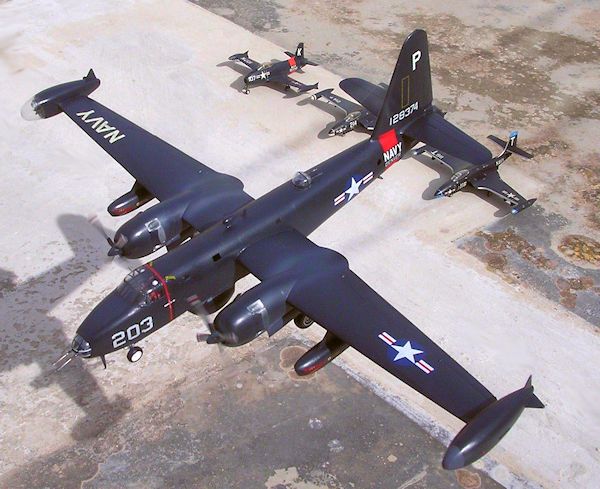 By
then the US Navy had an urgent requirement for such an aircraft. Lockheed
discovered that the Vega design proposal of 1941 could meet the needs with
little modification. Contract followed for two prototypes and 14 production
aircraft. The first prototype flew on 4th
May 1945. This carried a crew of seven, had a weapons bay for two torpedoes or
12 depth charges plus six defensive machine-guns. The P2V began entering service
in March 1947 and proved effective in their role.
By
then the US Navy had an urgent requirement for such an aircraft. Lockheed
discovered that the Vega design proposal of 1941 could meet the needs with
little modification. Contract followed for two prototypes and 14 production
aircraft. The first prototype flew on 4th
May 1945. This carried a crew of seven, had a weapons bay for two torpedoes or
12 depth charges plus six defensive machine-guns. The P2V began entering service
in March 1947 and proved effective in their role.
The
Korean war expanded the requirement for such an aircraft and the later
involvements of the US in South East Asia, plus need to provide similar
capability for western allies kept Lockheed busy providing P2V in multiplicity
of versions with the final production figure totalling1,181 aircraft.
The P2V-5 was a
major production version, an ASW aircraft in many sub variants, differed
basically from P2V-4 by having 3, 250 hp R-3350-30WA engines and larger capacity
wing tip tanks. It was retrofitted with a glazed nose and MAD equipment and 424
were built. P2V-5F (later P-2E) generally similar as P2V-5 but with 3,500 hp
R-3350-32W engines and two under wing mounted 3,250 lb thrust auxiliary
turbojets. (The scale model depicts a typical P2V-5F that formed part of the
Denver reserve Navy squadron in 1955.)
Neptune
connection with Malta
A serious accident on Luqa airfield runway
occurred on the 8th of October 1952
when a P2V-5 Neptune 127724 of US Navy crash landed during an emergency and was
destroyed by fire. In
1953 RAF Neptune MR1 WX516 (L-T) of 210 Squadron from
Topcliffe visited Luqa for the first time. The aircraft eventually found its way
to the Argentine Navy.
Movements
at Luqa airfield increased steadily during 1953 from 2,326 in July to 3,232 in
November. Included in the figures were a number of Neptunes of 36 Squadron RAF.
These arrived in November from Topcliffe and there was also at the same time a
detachment of US Nav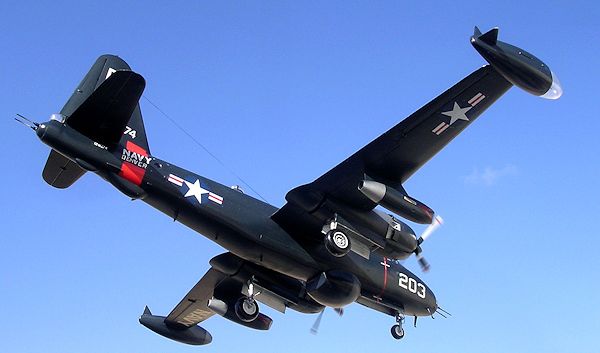 y
Squadron VP-21 and FASRON 104.
y
Squadron VP-21 and FASRON 104.
In 1956
there was another incident involving a Neptune MR1 WX547 of 1453 Flight,
Topcliffe and was using call sign Sterile Y. This had the collapse of the
undercarriage. This aircraft flew again and was sold for filming purposes in May
1957.
On 12th
September 1953 a French Navy Neptune with call sign FYAGB visited Luqa. In 1961
a French Navy squadron came for exercises to Luqa.
Luqa was
not the only airfield in Malta to be visited by the early version of the
Neptune. In August 1955 Neptune from VP-21 landed at Hal Far.1958 saw Neptunes
P2V-5 of USN squadron VP-24. These operated alongside Warning Stars WV-2 during
the visit. During 1956 Neptunes that visited Hal Far airfield came from VP-21,
VP-24, VA (HM)-13 and in May to October 1957 Neptunes from VP-23 were based at
Hal Far. In 1958 again Neptunes from VP-11 and VP-23 visited Hal Far.
Neptunes
were based at Hal Far (Malta) or Souda (Crete) to carry out functions as
monitoring Soviet Bloc maritime activity in the Mediterranean Sea and
surveillance of shipping in the same area.
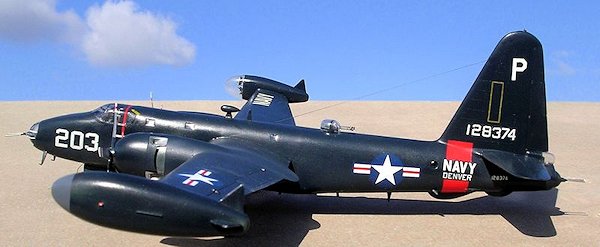 The
Hasegawa model of the Neptune represents the later P2V7 version. A good kit to
start with though it starts to show time on it. A kit
preview
made by Scott can be found
at
this link.
Modifying the P2V-7 required to re-profile the nose, the fuselage tail end,
re-position of radome, replacing the wing tip tanks and adding rectangular and
round windows as well as replacing the bulbous canopy with a flat one, plus
other minor details. The kit conversion is not so tough as it may sound since
all the conversion and detail parts required are readily available by after
market kit parts suppliers.
The
Hasegawa model of the Neptune represents the later P2V7 version. A good kit to
start with though it starts to show time on it. A kit
preview
made by Scott can be found
at
this link.
Modifying the P2V-7 required to re-profile the nose, the fuselage tail end,
re-position of radome, replacing the wing tip tanks and adding rectangular and
round windows as well as replacing the bulbous canopy with a flat one, plus
other minor details. The kit conversion is not so tough as it may sound since
all the conversion and detail parts required are readily available by after
market kit parts suppliers.
Converting
the Hasegawa Neptune model into an earlier version involves removing the front
and end part of fuselage and fix in place the vac form parts provided in Falcon
kit set VII, detailing the cockpit office utilising Pavla Resin set 72069 with a
little modification and also making good use of SAC landing gear set 72015.
The
Falcon set is a
delightful conversion for anyone with a desire to tackle any Neptune
alternatives in the category of P2V-5, P2V-5FS, DP-2E, SP-2E, OP-2E, P2V-6, RAF
MR1 or MR1 later version. These all carry a wide range of colour schemes. The
vac form parts are well detailed and panel lines are clean and neat.
Reference was made to the scrap drawing that comes with
the Falcon instructions. The Hasegawa kit fuselage halves are first taped
together and marked and cut at two places using a razor saw. Short tabs made
from plastic card are added t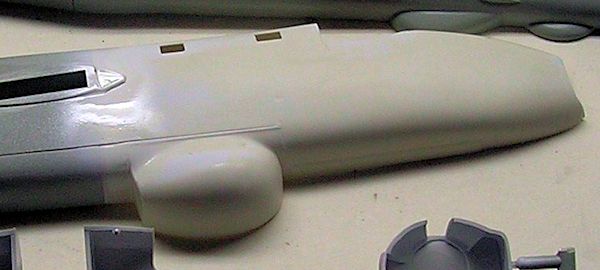 o
the cut ends to assist align when the vac-parts are butt joined to the fuselage.
The vac fuselage parts are cut, sanded and prepared for a later step when they
come to join the Hasegawa fuselage.
o
the cut ends to assist align when the vac-parts are butt joined to the fuselage.
The vac fuselage parts are cut, sanded and prepared for a later step when they
come to join the Hasegawa fuselage.
The
Falcon fuselage had square cut windows just behind the cockpit, the forward
window is rectangular while the one next to it is square. Cockpit is built up
making good use of the excellent Pavla Models resin detail set 72069 which
consists of a cockpit office and detail seats, central console, instrument
panel, side consoles, radar scanner and top instruments that fits to the canopy.
This was modified and shortened to suit the new vac- canopy that comes with the
Falcon set.
The Pavla instructions also indicate to remove the kit coaming.
The cockpit detail parts were also painted as per Pavla instructions. I also
added two crew figures, which were painted in costume of the same era. These add
relative scale to the kit.
Turning to the
Hasegawa fuselage, this had the aft square windows with the same clear kit part,
added filler and sanded flash. Then new round windows are drilled and shaped at
a new position to the previous ones making reference to the Falcon side view
drawing. The front ball turret had a clear part; this was damaged in my sample.
A spherical marble, that we used to play with when we were kids, provided the
exact match to use as male and I soon molded one from clear acetate. This was
then trimmed, and twin guns made from surgical needles added to it. The aft tail
barbette turret that was of slightly different shape was also prepared and
another pair of guns added. The top clear observation post positioned above the
tail guns was cut and prepared to fit as required.
All the
fuselage interior parts were painted in chromate green and all parts mated
together to the Hasegawa fuselage. A little filler followed by sanding produced
a clean smooth surface.
The mid fuselage turret
 was
also moved forward by ¼” to its previous position. Lead balance weight was added
and well secured at the back of the cockpit. More flat lead pieces were also
added to cowling empty fronts, which were blanked with a round piece of plastic
card. The rest of Hasegawa main planes etc were assembled according to kit
instructions
was
also moved forward by ¼” to its previous position. Lead balance weight was added
and well secured at the back of the cockpit. More flat lead pieces were also
added to cowling empty fronts, which were blanked with a round piece of plastic
card. The rest of Hasegawa main planes etc were assembled according to kit
instructions
The kit
narrow tip tanks were replaced with the more bulky ones that come with the
Falcon kit. Close up photos of the wing tip searchlight and instruments inside
were referred to and the arrangement detail was scratch built. The tank halves
were joined together and wing finlets made from backing plastic sheet also
shaped and joined to the tank ends. A transparent clear cover then fixed to the
searchlight.
The kit
wheel wells were bare from detail also merited adding detail to the interior
with webbing arrangement using shaped plastic card parts prepared.
I also added a set of detailed Scale Aircraft Conversion
undercarriage metal legs that comes for the Neptune.
I noticed
that SAC undercarriage set has an improvement in definition and consistency in
detail as compared to the kit offering. There is practically very little cleanup
required which is removing the faint parting line and were ready to fit in
place. The legs were painted aluminium at sliding places and the rest white. A
little raw amber oil paint wash popped out the detail. SAC parts have crisp
detail for the torque links and another advantage of this is that there are no
knock out marks on any of these SAC metal parts. I found these metal parts very
helpful when fixed in place to have the model resting firmly and could stand the
handling during the final detailing and paintwork of the model. On occasions
when I used the kit plastic ones I accidentally knocked these off.
Other detail
added to the kit was the bullet shaped top of fuselage RDF antenna in place of
the astrodome, blade antennae to top and bottom, wireless and small central
bracket added to inside of each engine gill which were fixed slightly open.
Referring to ‘P2V
Neptune in Action’, a Squadron Signals No 68 issue there is a picture of the
aircraft suggested by Falcon and I noticed that the Falcon side view given had
some inaccuries. The tail root serial should be 128374 instead of 128734 while
the presence RDF antenna and extra window at front was not indicated on drawing
as a scrap view.
The kit
is completed as an early P2V-5F9 (128374) which has also the early gun
installation mounting twin 20mm cannon in both nose and tail position. The
machine carries the large central wing tip mounted 350-gallon tank. It is
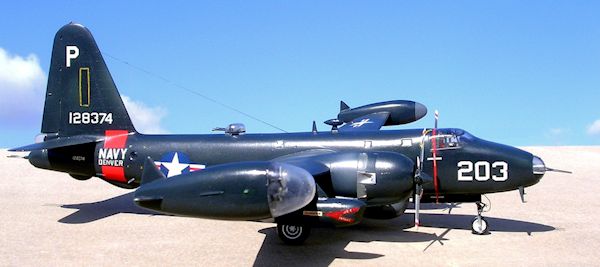 a
Denver NAS based Neptune circa 1955.
The aircraft is overall sea blue (Compucolor CA 13 ANA
623) and an International orange reserve band at the back of fuselage.
Early Neptunes had chromate green wheel wells but being
at a time when the sea blue was going out of fashion in favour of white and gull
grey these were completed white as the order of the day.
a
Denver NAS based Neptune circa 1955.
The aircraft is overall sea blue (Compucolor CA 13 ANA
623) and an International orange reserve band at the back of fuselage.
Early Neptunes had chromate green wheel wells but being
at a time when the sea blue was going out of fashion in favour of white and gull
grey these were completed white as the order of the day.
All
decals including all numerals, danger markings and arrows and national insignias
came from Super Scale different sheets. Kit was given a coat of Klear before and
after application of the decals. Only the large white NAVY and danger air intake
markings were kit decals. The completed model was in the end given an overall
coat of Alklad 2 Lacquers that is Klear Kote Light Sheen that I bought from
K-Hobbies of Fgura.
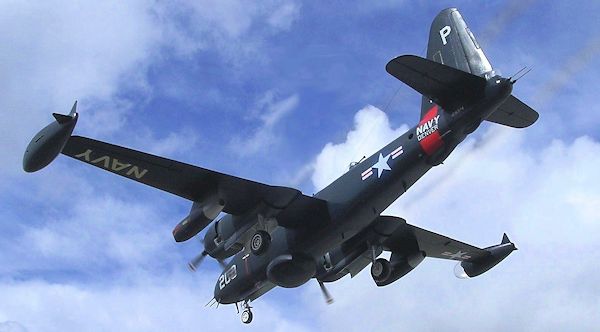 This
is a scale model conversion containing parts from four different sources,
probably the only available method to make an early version of the Neptune at
the scale of 1/72. I guess it was worth the effort as the final resulting kit
appeared very pleasing. Similar early version P2V-5 can be made without the
under wing jet engines and with vivid day glow colours can also be made using
the Falcon fuselage conversion parts.
This
is a scale model conversion containing parts from four different sources,
probably the only available method to make an early version of the Neptune at
the scale of 1/72. I guess it was worth the effort as the final resulting kit
appeared very pleasing. Similar early version P2V-5 can be made without the
under wing jet engines and with vivid day glow colours can also be made using
the Falcon fuselage conversion parts.
Carmel J.
Attard
February 2013
If you would like your product reviewed fairly and fairly quickly, please
contact
the editor or see other details in the
Note to
Contributors.
Back to the Main Page
Back to the Review
Index Page





 o
the cut ends to assist align when the vac-parts are butt joined to the fuselage.
The vac fuselage parts are cut, sanded and prepared for a later step when they
come to join the Hasegawa fuselage.
o
the cut ends to assist align when the vac-parts are butt joined to the fuselage.
The vac fuselage parts are cut, sanded and prepared for a later step when they
come to join the Hasegawa fuselage. was
also moved forward by ¼” to its previous position. Lead balance weight was added
and well secured at the back of the cockpit. More flat lead pieces were also
added to cowling empty fronts, which were blanked with a round piece of plastic
card. The rest of Hasegawa main planes etc were assembled according to kit
instructions
was
also moved forward by ¼” to its previous position. Lead balance weight was added
and well secured at the back of the cockpit. More flat lead pieces were also
added to cowling empty fronts, which were blanked with a round piece of plastic
card. The rest of Hasegawa main planes etc were assembled according to kit
instructions
